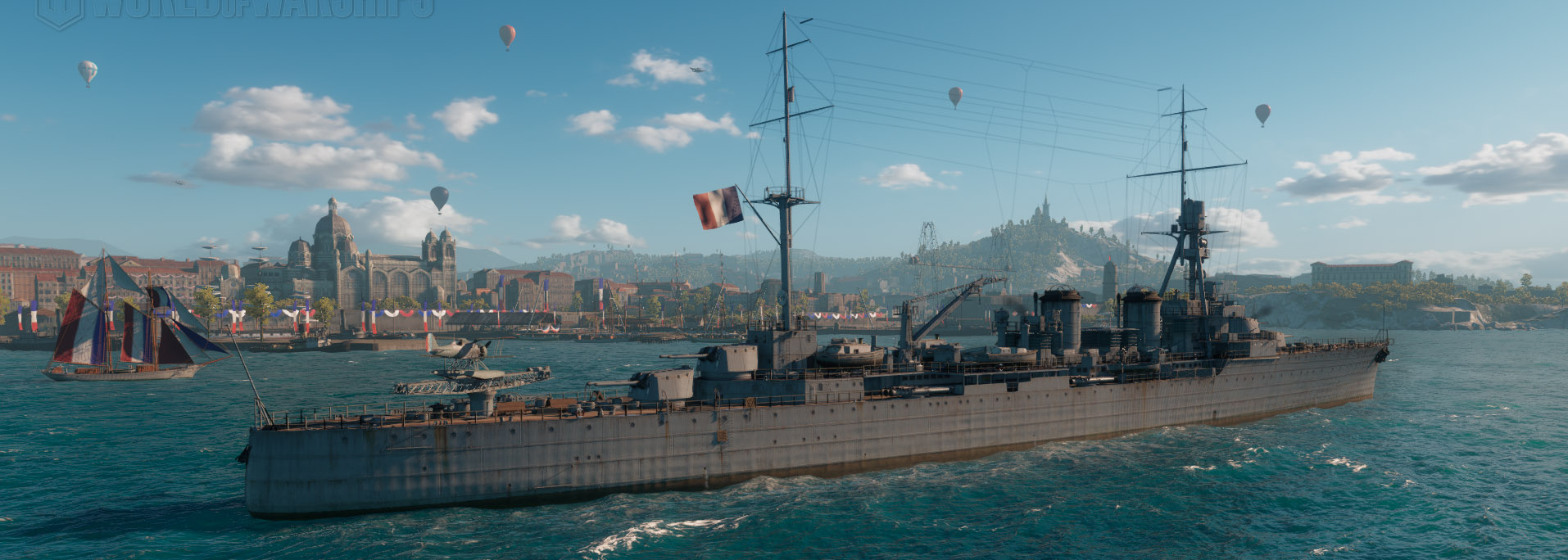
First French cruisers since 15 years: These three light cruisers, Duguay-Trouin, Lamotte-Picquet and Primauguet, were the first French cruisers built since 1906. The main reason was like for other countries, the revelation of HMS Dreadnought caused a brutal shift in naval spendings towards the new breed of Battleships. It was to the point that in France like in the US, cruiser design took a back seat. After a long serie of armoured cruisers, there were plans to create a light scout cruiser the likes of which became popular in the 1910s in UK and Germany as well as in Italy.
The 1912 plan scouts
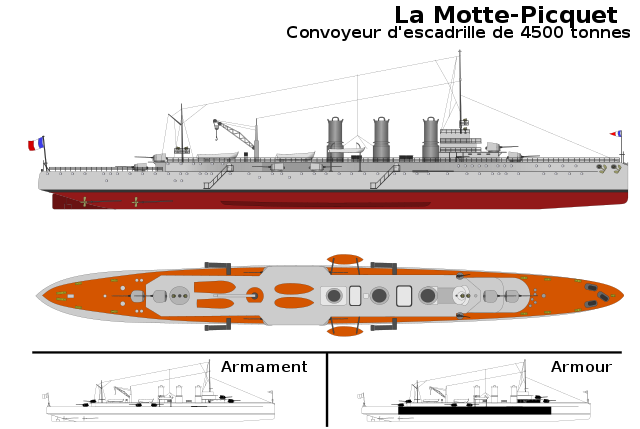
The very last French cruiser design was this 4,500 tonnes scout “convoyeur d’escadre” or lit. “Squadron Leader” to conduct destroyers in fleet screening operations. Planned in the March 1912 naval law pushed by Admiral Boué de Lapeyrière, they were however never ordered. The plan indeed included no les than 28 dreadnought battleships, 10 scout cruisers and 52 fleet torpedo boats. Only a small fraction ever saw the light before WWI broke out. Everything was concentrated on the new Bretagne class dreadnoughts at the time and the construction of the four initial scouts was delayed until November 1914, the first two to be ordered in Toulon. When the war broke out, these were cancelled.
Next, if France won WWI, it saw the French naval industry crippled in 1918. Most of its coal and suppliers had been captured beyond the frontline and workers had been bled out in the trenches. But in 1920, French naval yards just started to recover their potential. This was in part due to funding obtained by war reparations imposed on the Germans, whereas the fleet obtained four ex-German light cruisers to compensate for the losses. br>
Meanwhile, the staff’s design team started to study the latest one completing at the time, the Omaha class. They were carefully studied, with Italy as a potential rival, not working on new project but completing large destroyers like the Leone class, a real threat for French squadrons. Back in 1920, the fleet wanted a serie of new, large destroyers, led by light cruisers used as scouts and leaders. The admiralty simply retook revised plans of the Lamotte Picquet class and updated it for about six months, named ‘Projet 171’ in 1919.
The 1919 Project 171 and 1920-22 evolution (A to D)
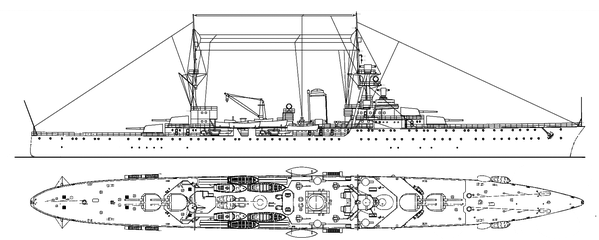
A rendition of the Project 171
This concerned six new light cruisers presented by the new French Minister of Marine, Georges Leygues, in January 1920. After a major restructuring plan, it was cut down to three. In addition, twelve new “torpilleurs-éclaireurs” (scout torpedo boats) were also scheduled, divided into three four-destroyer strong squadrons led by each of the cruisers. Like in 1912, their role was of fleet screening. The same plan also oversaw the conversion of the Normandie class Battleships into the aircraft carrier Béarn.
Discussion went on. Started in mid-1919, they were finalized into the detailed design Project 171 completed by the end of 1919, but significant reservations were expressed within the Navy, support by the Chief of the General Staff. They were eventually withdrawn in February 1920 and discussion resumed, with opportunities to compare new foreign designs, superior to the 1919 project and in partucular towards armament. Indeed, twin turrets were now becoming more common: They were already tried, like the shieled twin mount on the D-class HMS Diomede, or the true turret on “E” class HMS Enterprise, as well as the Omahas, showing that a single gun position can be used to double firepower. Therefore, Project 171, which had eight main guns in single positions, including four superfiring fore and aft, were naturally converted into twin mounts positions, and the side ones removed entirely.
Project 171 seemed to have the following specs: 145m (pp) x 146,3 (oa) long, 14,5m wide, 5,2 meters draft for 5.270 tons standard, 54.000 shp with Guyot du Temple boilers on two shafts (single funnel), and 30knots, armed with four twin 138mm/55 M1910, four single 75mm/50 M1920 AA and four triple 533mm Torpedo Tubes.
Discussions and reflections were brought to a conclusion, in a note dated 25 February 1920. The Chief of the General Staff requested the Minister to “withdraw Project 171”, replacing it with a new one. A few days previously he had consulted the Naval Constructor’s Department (note dated 21 February, 1920) in order to ascertain the displacement of the cruisers if speeds were raised to 32, 34 or 36 knots, all other conditions remaining unchanged.
The department replied on 23 March: 6,300 tons for 32 knots 7,500 tons for 34 knots and 9,000 tons for 36 knots. At the same time, it was indicated that the 7,500 ton-cruiser would have dimensions of 175m x length X 5.80m draft with 1,400 tons of oil fuel giving a range of 2,600 nautical miles at 15 knots and 155mm armament. In fact, the Design Department also had provided for other variants: 8,000 tons with 164.7mm armament and 12,000 tons with 240mm. Design studies were actually started for two of these variants, the 7,500 and 12,000 ton designs.
The 8,000 ton cruiser of the Duguay-Trouin class was foreshadowed in this and attention was given to the definition of a first stage of construction on which the C.S.M . would have to give its views. There were three possible schemes, depending on the period in which construction was possible:
– if 3 years: 3 cruisers of at least 6,000 tons, 12 destroyers of 2,000 tons and 10 submarines of 1 ,200 tons.
– if 4 years: 4 cruisers, 12 destroyers, 12 submarines and an aircraft carrier.
– if 5 years: same as for 4 years plus 12 destroyers of 1,200 tons.
This led to the more refined derivative design in mid-1920, refining some specs, notably still a light belt armor of about 70 mm, and a 30 knots top speed as required. Eventually in late 1920, US plans for the Omaha class were purchased eventually ands the admiralty started working on four definitive designs, A to D. These were drafted around the brand new designed 155 mm (6.1 in) main guns. They also carried four 75 mm (3 in) guns for anti-aircraft defence and twelve torpedo tubes in deck triple banks. The main differences only saw adjustments in powerplant and protection, after armament was agreed on.
These discussions went on throughout 1921, whereas from November 1921, French delegates came to the newly established Washington Naval Conference aimed at ending the rampant world’s naval race postwar. A crucal point was the acceptance by the naval powers of the time of a common cruiser caliber, from which emerged a maximum, 8-inches (based on the British Hawkins class). The light gun cruiser was established at 6-inches, but discussions led to a compromise to accept 155 mm as maximum caliber instead of 152 for the French case. Eventually after the signing in February 1922, the admiralty settled on the definitive design C, which appeared as the best compromise, but favouring speed over protection.
From there, the tonnage was checked well below the treaty’s max limitations of 10,000 tonnes and concessions obtained regarding cruisers and submarines. The latter was to be capped as proposed by Charles Evans Hughes, but both the French and British delegates refused categorically, based on their own colonial empires, which needed cruisers to guard the trade lines. Instead, the British propopsal of a qualitative limit was adopted with ease. No limitations for what was to be a “light cruiser” was imposed, so the French design was done without constrains but the global ratio of cruiusers, taking in account six heavy cruisers planned for FY1923.
Manwhile the “Italian scare” proved to be unfounded as the latter only started their light cruiser program in response of French large 1923 destroyers. These would be launched only in 1928, with the Trento class (1927) answering the first French heavy cruisers.
Design
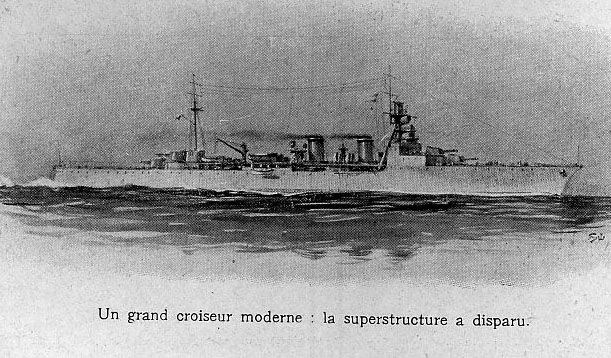
Duguay Trouin on L’illustration review
The hulls of these ships have been carefully studied to take full advantage of the available power of modern triple expansion boilers associated with turbines. The speed of 33 knots had been considered as soon as the plans were drawn. Their Model 1920 155 mm guns reached 26,100 meters, but at a rate of fire of four shot per minute, which was relatively slow at the time, more so in 1939. They also set up a trend in cruiser design for the French in the interwar, with a “classic appareance”, forecastle, two funnels, two masts, two superfiring turrets fore and aft, and a low bridge, CT and main telemeter mouunted on a tripod rather than a “full” superstructure.
For the French, large superstructures like those of the US, British or Italian vessels were considered as an unwanted “sail” in high wind and causing a stability hazard. The French liked large open bridges, just above the superfiring turret roof level. A second admiralty bridge was present however at the base pof the main tripod leg (axial formast). They also trusted more the tripod rather than a solid superstructure, with some reasons. They only evolved their design with the arrival of the revolutionary Algérie, which set a new standard.
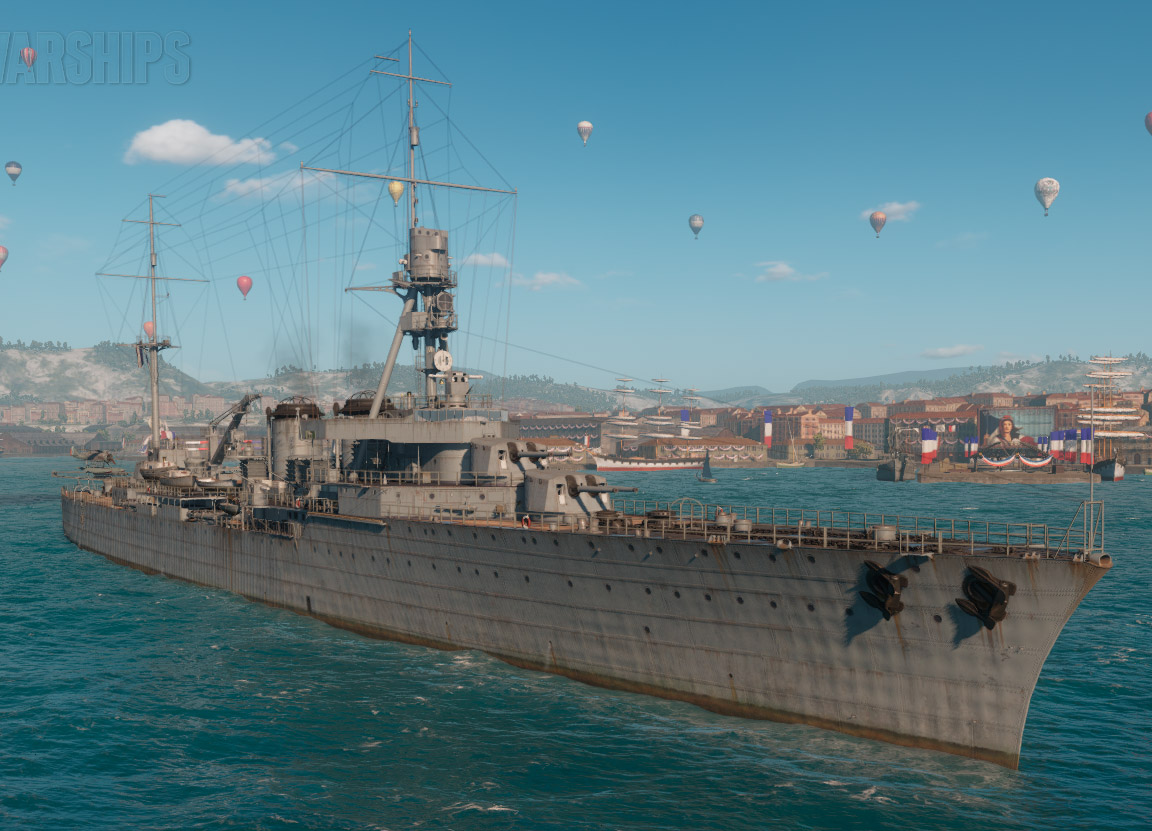


Wow’s renditions.
Powerplant and performances
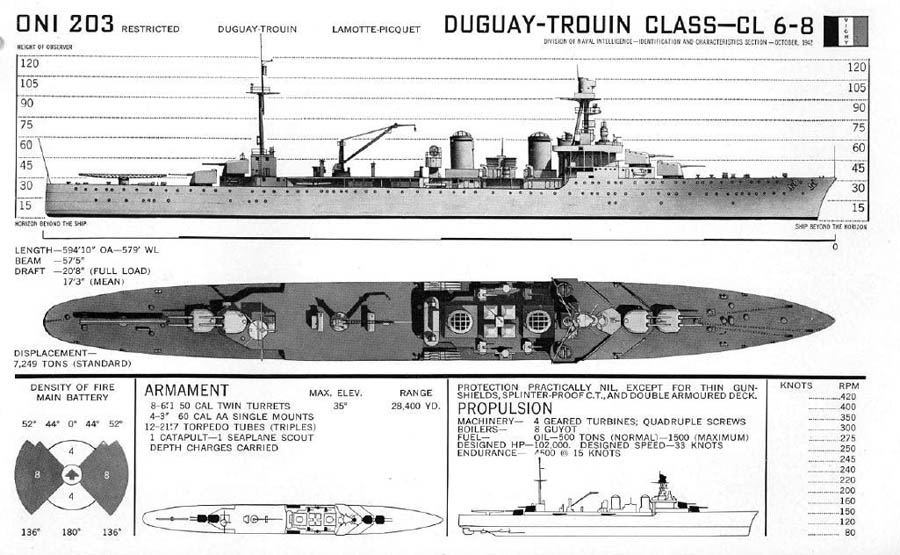
Duguay Trouin in 1942, ONI
The Duguay-Trouin class cruisers had four propoeller shafts, drived by four sets of Parsons geared steam turbines, fed in turn by eight Guyot du Temple boilers. In total, this powerplant developed 100,000 shp for 33 knots. This set an absolute records fro French cruisers up to that point, the next heavy cruisers would try to beat. 33 knots was from there considered the ideal top speed for the fleet.
Sea trials were successful, as these ships easily exceeded 34 knots, and were able to maintain 30 knots on half of their boilers up for more than 24 hours, which at the time was an excellent performance. Their range was however a bit low at 4500 nautical miles at 15 knots or 6,000 km at 14 knots, just enough for fast sorties in the Mediterranean. They carried 1,500 tonnes of oil.
They were considered good seaboats too, being tall, and thus, seaworthy, with fine hull lines, and responsive at the helm. However as expected they bled 50% speed when the rudder was hard over. After all, they had been built in Brest on the Atlantic coast, and were rugged vessels able to serve on the north sea and Atlantic if needed. No case of excessive vibration problem was reported either, which was common at the time for “tin clad cruisers”.
Armament
4×2 155 mm (6.1 in)/50 Arsenal de Brest
The 155 mm/50 (6.1″) Model 1920 was was in twin turrets but not individually sleeved. They were also mounted on casemates on the aircraft carrier Bearn. The school cruiser Jeanne d’Arc also had four turrets with the same. Developed from Army guns in 1920, completed in 1923 and produced with an autofretted A tube, a liner, jacket in two lengths and breech ring, and the Welin breech mechanism block opening upwards. Introduced in 1926, this gun had the following specs:
- 8.73 tons (8.87 mt), 316.9 in (8.050 m) long overall
- 46 grooves, uniform twist RH 1 in 22.35, vol. 2,238 in3 (36.67 dm3)
- Rate Of Fire: 3-5 rounds per minute
- Shells: -SAP M1924 (124.6 lbs/56.5 kg)
-HE with internal nose fuze (130.1 lbs/59kg)
-HE base fuze (124.6 lbs/56.5 kg)
-Illumination shot - Bursting charge 7.3 lbs. (3.3 kg) SAP to 6.5 lbs (2.9 kg) cast TNT HE
- Propellant Charge: 43.67 lbs. (19.81 kg) BM11
- Muzzle Velocity (SAP M1924) 2,854 fps (870 mps), HE 2,835 fps (864 mps)
- Max range (HE): 28,543 yards (26,100 m)
- Ammunition stowage, per gun/global: 125/1,000 rounds
- Barrel life: circa 700 shots.
The turret had the following specs: 78.7 tons (80 mt), Elevation -5/+40° at 6° sec. -140/+140° training at 6.4°/sec. Gun recoil 19.7 in (50 cm) to 21.7 in (55 cm). These were not successful ordnance pieces. They were unreliable and experienced “regular breakdowns” in reports, in addition to their relatively slow rate of fire. Also, due to the “poison gas scare” in 1919 they were designed as completely air-tight with overpresure and force ventilation, which did not always worked well. The turrets were also cramped compared to the Jeanne d’Arc ones, made larger for the instructors and cadets. In short these French 1st generation cruiser twin turrets were not very successful. Considerable lessons were learned to benefit the Emile Bertin and La Galissonnière class.
4×1 75 mm (3 in)/50 Schneider
Called the 75 mm/50 (3″) Model 1924 in that case. They were derived from the 75 mm/62.5 (2.95″) Model 1908, and improved in 1922. This was obtained by shortening the barrel and fitting a high-elevation mounting. It was however obsolete in 1940, lacking fuse shells and way too slow. For faster loading, they fired fixed rounds (cartridges). They weighted 1.05 tons (1.07 mt) each with about 4 meters long barrels. The four unshielded mounts (at first) were located abaft the two funels, behind the bridge and forcastle, on the upper deck. Not ideally placed for the arc of fire, at least for the two forwards ones. In the 1930s they received enevloping shields, covering a part of the sides and top.
- Round weight: 26.5 lbs. (12.01 kg)
- Round size: 12.8 in (32.5 cm), 38.1 in (96.67 cm) full
- Round Type: 13.07 lbs. (5.93 kg) HE or Starshell
- Charge: 4.81 lbs. (2.18 kg) BM5
- Muzzle Velocity: 2,789 fps (850 mps)
- Ammo stowage: 135 rounds x4
- Elevation: -10 / +90 degrees, traverse 150° either side
- Ceiling: 26,250 feet (8,000 m), 24,600 ft effective
- Range: 15,420 yards (14,100 m)
- Rate of fire: 10 rpm average.
4×3 55 mm (21.6 in) Torpedo Tubes
Likely the 55 cm (21.65″) 23DT models of the arsenal de Toulon at first planned (service 1925) also shared by destroyers. They were powered by a Schneider alcohol/air heater system to two settings, 9,840 yards (9,000 m) and 39 kts and 14,200 yards (13,000 m)/35 kts. They measured 27 ft. 2 in. (8.280 m) for 4,560 lbs. (2,068 kg), carrying a 683 lbs. (310 kg) TNT warhead. They carried a total of 12 torpedoes in their tubes, with a single reload, thus 24 in all aboard;
Other specifics
The gunnery was conducted by a single main telemeter installed atop the tripod foremast platform. It was armoed with 20 mm plating and directed the main fire for all four turrets. It was seconded by two auxiliary telemeters on either side at the level of the bridge, and the AA telemeter installed on the conning tower’s roof. An extra telemeter was probably installed aft for the torpedo tubes.
These cruisers also carried two saluting guns placed on the upper deck forward, behind and either side of “B” turret. The ships also carried paravanes, two pairs fore and aft installed on the superfiring turret superstructures walls. For target illumination by night, they also carried two projectors installed on a platform aft of the second funnel. Boats were served by a gooseneck crane on pivot situated on the large aft arear after the projector platform and before the main mast. A diesel picket/staff boat could be carried as well as two dunghies, two yawls, two cutters.
Armament upgrades
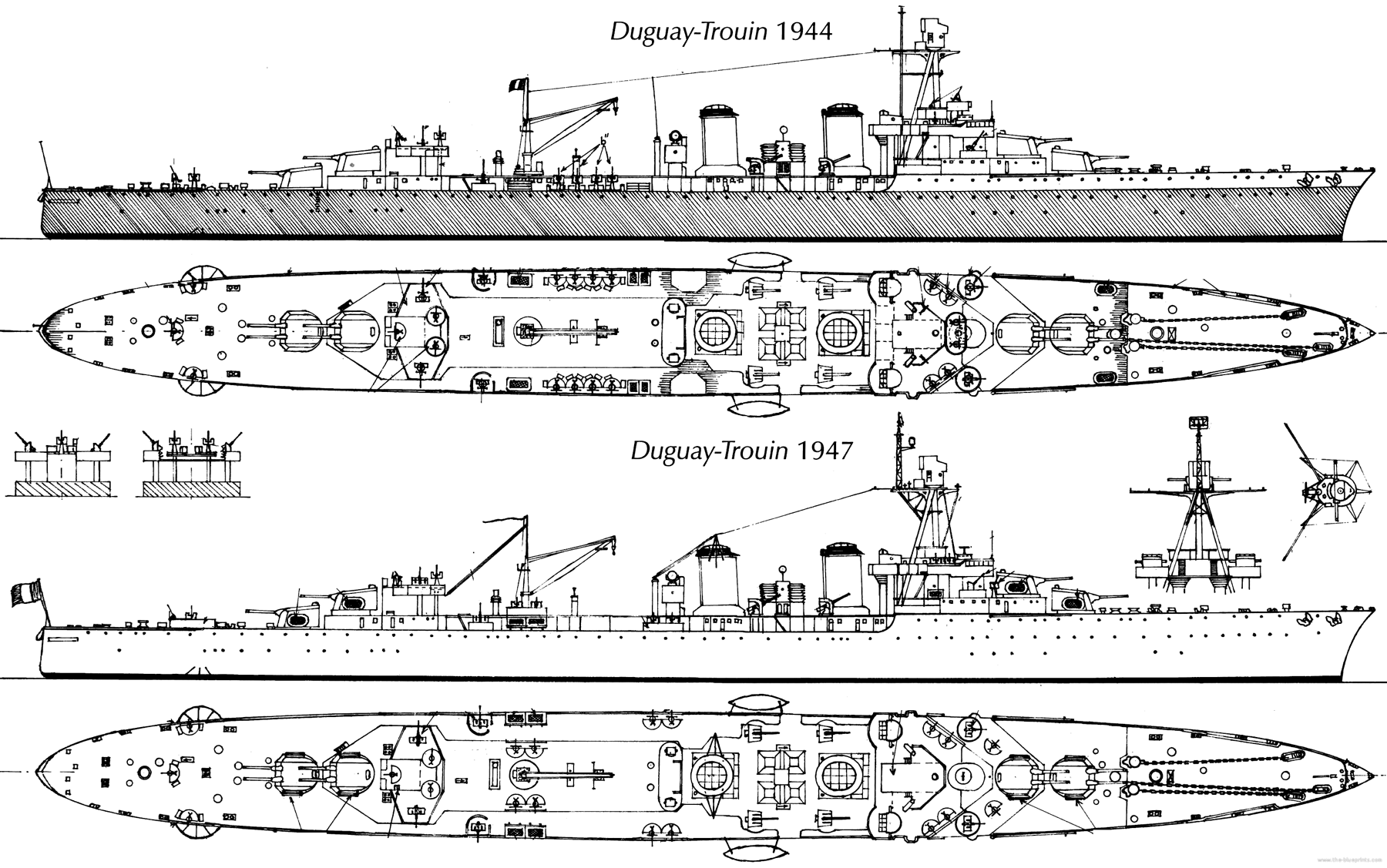 Duguay Trouin in FNFL service in 1944 and in 1947 as modernized.
Duguay Trouin in FNFL service in 1944 and in 1947 as modernized.
In 1932-33, all three vessels received at last some extra AA, six Hotchkiss twin 13.2mm/76 machine guns. In 1937 Primauguet received in addition two single Hotchkiss 25mm/60 M1938, AA guns and four additional quadruple 13.2mm/76 Hotchkiss AA HMGs.
In 1942 Primauguet had two triple 55cm TTs banks removed. In October 1943, Duguay Trouin had likely it’s 75 mm guns removed, and four twin 13.2mm/76, still its four triple TT banks, catapult but had received an additional two single 13.2mm/94 guns and in January 1944 only two twin 13.2mm/76 plus single single standard allied 40mm/56 Mk 1.2 AA guns, plus twenty single 20mm/70 Oerlikon Mk 4, and two single 13.2mm/94. FFor the first ttime, electronics were installed, a standard air search radar SF-1 and by late 1945, she received two extra 20mm AA guns and two 13.2mm/94 HMGs, and a SA radar.
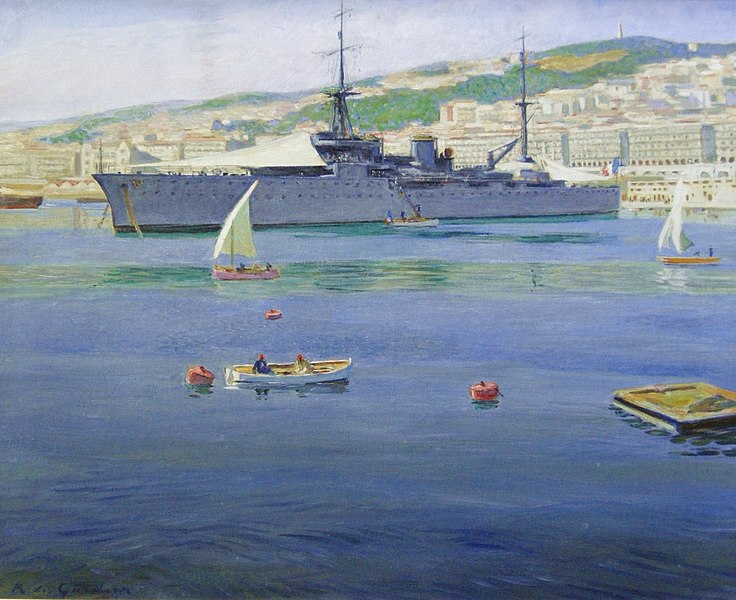
Duguay Trouin in Algiers, by Raoul du Gardier
Armor protection
The protection was the poor child of this design, with however a very strong watertight subdivision around the engine room, with 16 watertight compartments under the waterline, and a full double bottom and double hull around the machinery spaces. It had no belt, but a “citadel” limited to the most senstive parts of the ship. It also seemed to have a sufficient protection of the roof of the turrets. As protection against combat gases had been envisaged, turrets were also conceived as fully hermetic.
- Deck: 20 mm (0.79 in)
- Magazine box: 30 mm (1.2 in)
- Turrets: 30 mm (1.2 in)
- Steering gear: 20 mm (0.79 in)
- Conning tower: 30 mm (1.2 in)
Onboard aviation
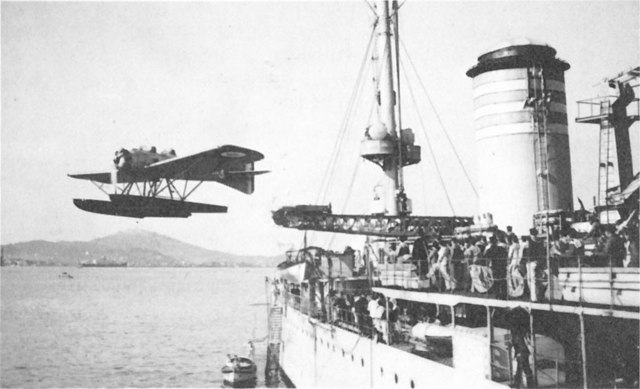
Gourdou-Leseurre GL-812 HY launched from Tourville in 1928.
These ships were fitted with an aft catapult, axial, installed after the two superfiring turrets on deck. The ships received two to three seaplanes (two could be stowaged either side in theory) but in reality, one was carried ready on the catapult at all times. Recuperation was done by using the gooseneck crane, but it was too far away to have the plane repositioned on the catapult.
These ships carried at first the LGL 31 HY (“HYdravion”), and later the LGL 32 HY from Loire Gourdou Leseurre. And then the Loire 130. The first was a simple twin-pontoon floatplane two seats, unarmed, radial engine mid-wing monoplane model with a top speed of about 215 km/h (134 mph; 116 kn) at 8,000 m (26,000 ft). The Loire 130 appeared from 1937 was more comparable to the British Walrus. It had a far longer range of 7.5 hrs, 220 km/h top speed at 2,100 m (6,890 ft), 6,000 m (19,685 ft) ceiling and could carry 2 x 75 kg (165 lb) bombs, being armed with two LMGs. It was pushed engine configuration, mid-wings seaplane with small floats under the wings.
On navypedia it is mentioned thay could also carry two floatplanes in 1927, either Besson 35 or F.B.A.17, but i can’t find any confirmation. In 1943, catapult and aircraft were eliminated on Duguay Trouin for her major modernization.
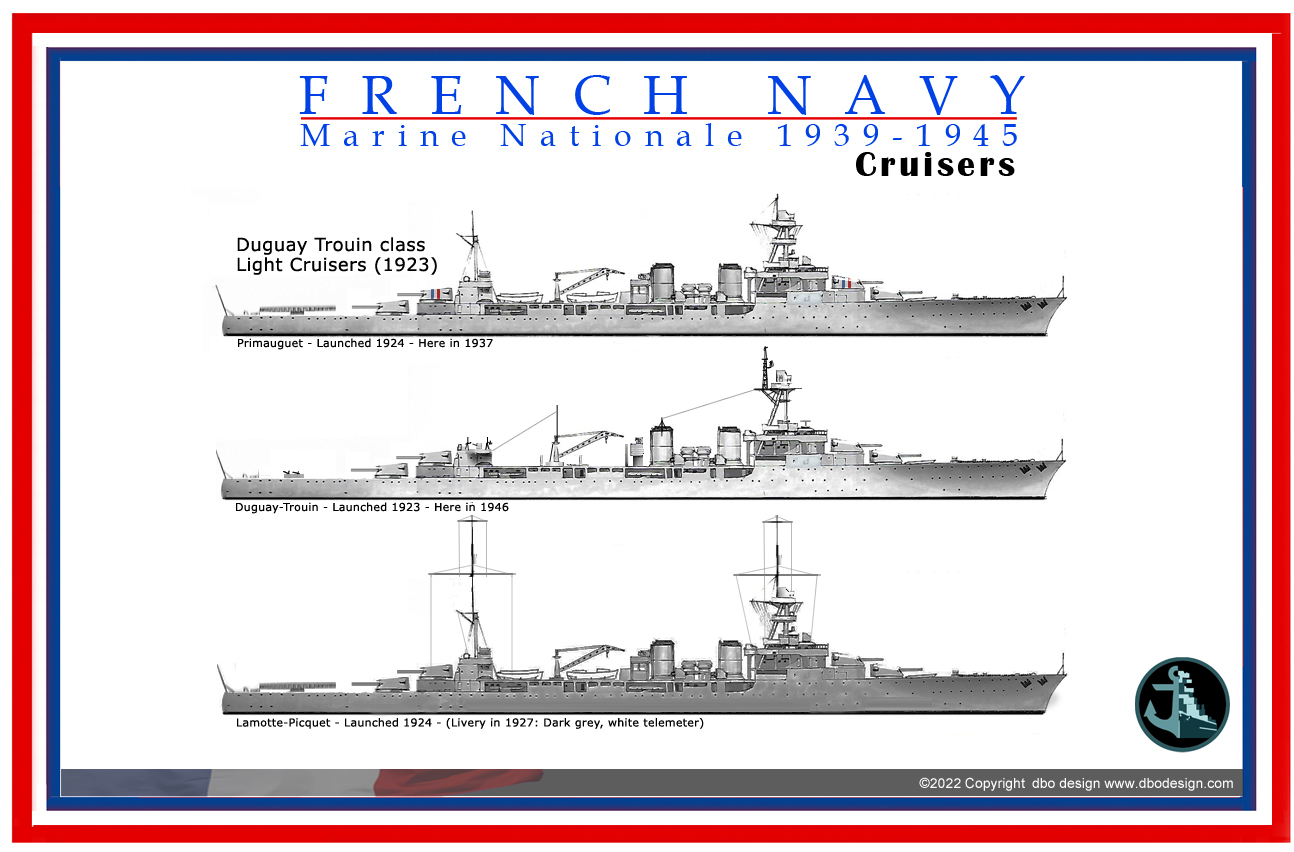
Appareance of all three cruisers before and during WW2.

Lamotte-Picquet in 1941, before the battle of Koh Chang.
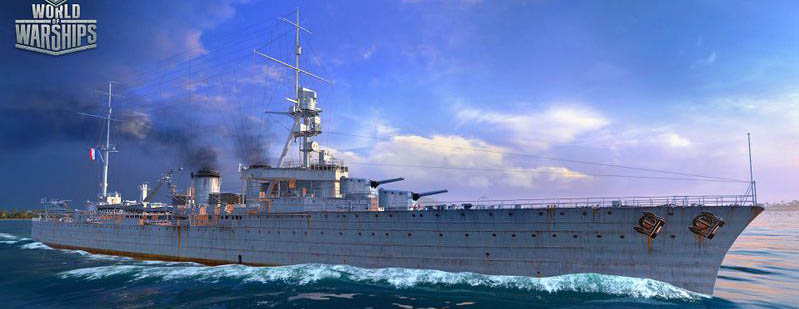
3D rendition by world of warships
⚙ Duguay Trouin class specifications |
|
| Dimensions | 181.3 m long, 17.50 m wide, 6.15 m draft () |
| Displacement | 7,250 t. standard, 9,350 t. Fully Loaded |
| Crew | 690 |
| Propulsion | 4 shafts Parsons turbines, 8 Guyot boilers, 120,000 hp. |
| Speed | 30 knots (56 km/h; 35 mph) |
| Range | 3,000 nmi (5,600 km; 3,500 mi)/15 kts (28 km/h; 17 mph) |
| Armament | 8x 155 mm/50 (M1920), 4x 75 mm AA, 4×3 550 mm TTs, Loire 130 seaplane. |
| Protection | 20 mm belt, deck, 15 mm ASW bulkheads, 30 mm turrets, CT. |
 Duguay-Trouin
Duguay-Trouin
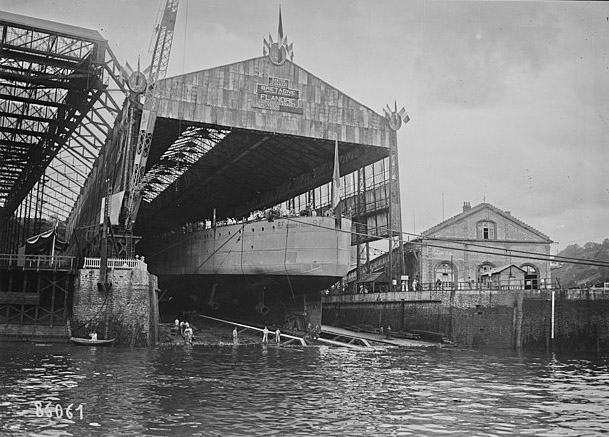
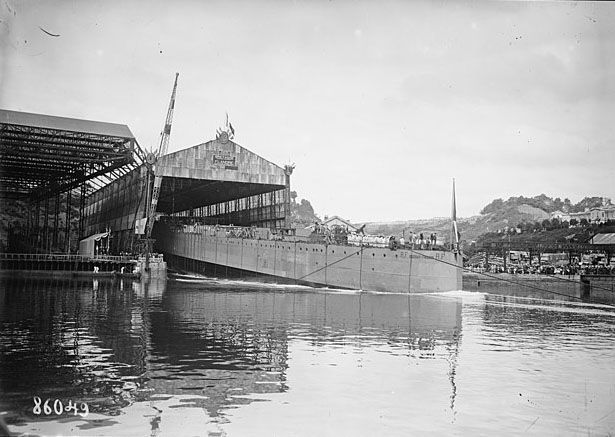
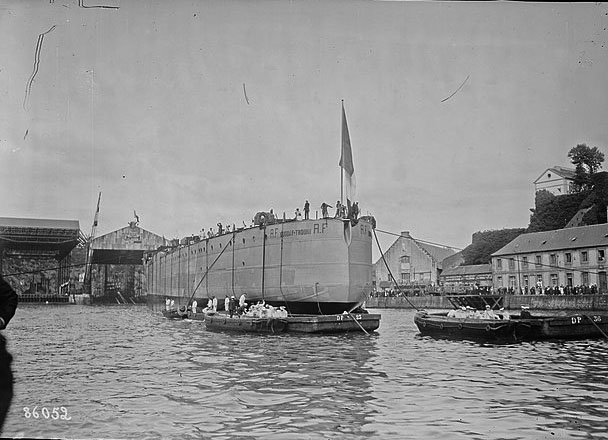
Duguay Trouin launch in Brest.
Duguay-Trouin was launched on 14 August 1923, and the longest light cruiser of her time, fitting out and entering active service on 2 November 1926. She was assigned to the 2nd Squadron in Brest at first. In 1929, she became flagship, 3rd Light Division this tile in Toulon, Mediterranean. In 1931, she made her first long range cruise to French Indo-China and cross the atlantic to return the 2nd Squadron in Brest in 1932, also as flagship, a position she held until 1935.
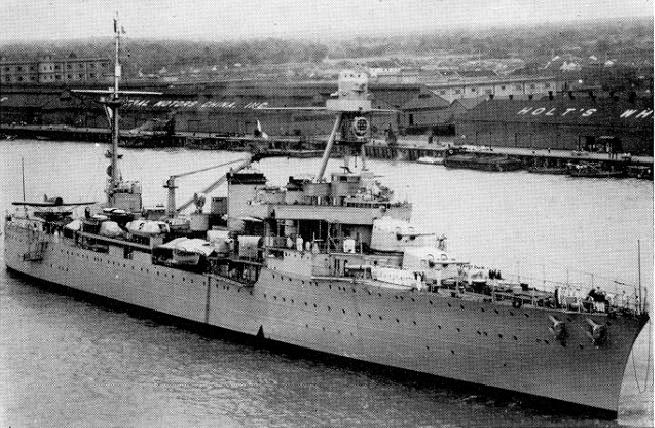
In 1936, she took her tour of duty to enforce neutrality ans safeguard French and international citizens’s interests and safety, during the Spanish Civil War. At the time, like many ships of other nationas to avoid being misidentified, the top of her upper turrets was painted in Blue-White-Red. In 1936, she became a gunnery training ship, withing for a major refit, which came in 1937. Her anti-air artillery was notably improved and in 1938 Captain de Prévaux took command. She would stay under his command during WW2.
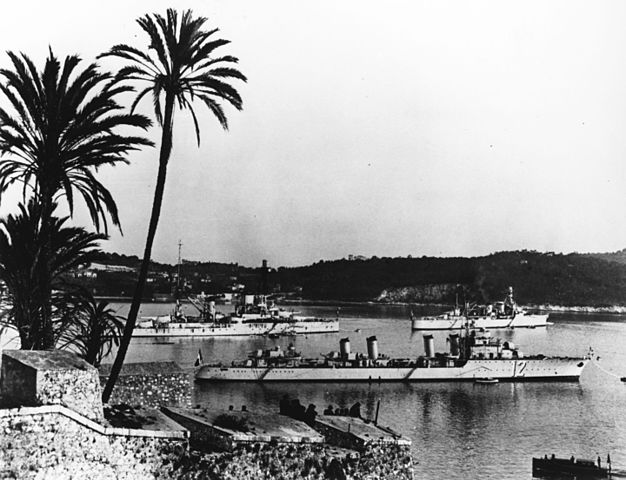
Duguay Trouin and the destroyer Vauban in VilleFranche, Mediterranean, 1938
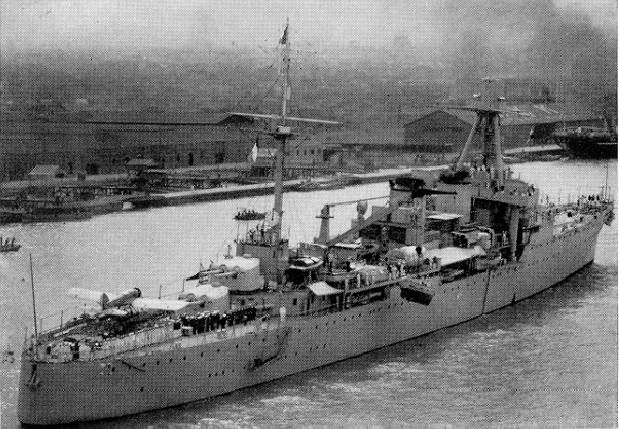
By June 1939, she joined the 6th Cruiser Division and by 3 September 1939 she was in Dakar, French West Africa, ready to patrol the Atlantic, which it did after the war broke out, in search of axis merchant vessels and possible commerce raiders. She pperated with the Royal Navy and notably receicved the orders to search for KMS Graf Spee. On 16 October 1939, she intercepted the German merchant ship Halle, some 200 miles SW of Dakar, but the crew manage to scuttle her to prevent capture.

In May 1940 she was posted in the eastern Mediterranean, and based in Beirut, in the French protectorate of Lebanon. She was made ready for operations in the Adriatic and Dodecanese. By July 1940, followed the surrender, she was ordered to join Admiral René-Émile Godfroy’s Force X based in Alexandria, Egypt, under the watchful eye of the Royal Navy. There, she was disarmed by agreement during Operation Catapult, interned. When Axis forces invaded the Vichy-controlled “Free Zone” in November 1942 following Operation Torch, she was freed from armistice conditions, to join the FNFL (Free French Navy).
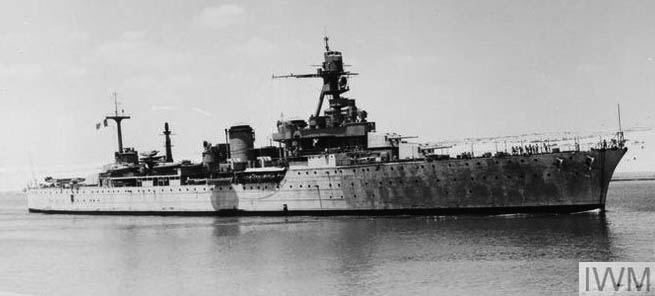
Duguay Trouin departing Alexandria via the Suez canal, 23 June 1943 (IWM)
On 30 May 1943 she was made ready again, rearmed in July, she moved to Dakar in September 1943, after crossing Suez and cornering Africa. She was modernized in Casablanca and Oran (radars, new AA and other modifications). She made many patrols in the Atlantic and Mediterranean. In March 1944, she ferried allied troops between Algiers, Ajaccio, Oran and Naples and supported the landings in southern France in August (Operation Anvil Dragoon) shelling also later the Italian coast with “Flank Force”n until April 1945.
On 10-11 May 1945 already, Duguay-Trouin was recalled to Algeria where an insurrection was going on, shelling villages during the Sétif and Guelma massacres. On 28 May 1947, this was the start of the Indochina War, and she went there, via Diego-Suarez (Madagascar), arriving on 13 November and remaining there until September 1951, as flagship of the Far East Division for 400 combat days. She shelled Viet-Minh positions along the coast and covered commando landings from 1948 to October 1951. Recalled back home, she was decommissioned on 19 March 1952, sold the next year after quite a long and active career.
 Primauguet
Primauguet
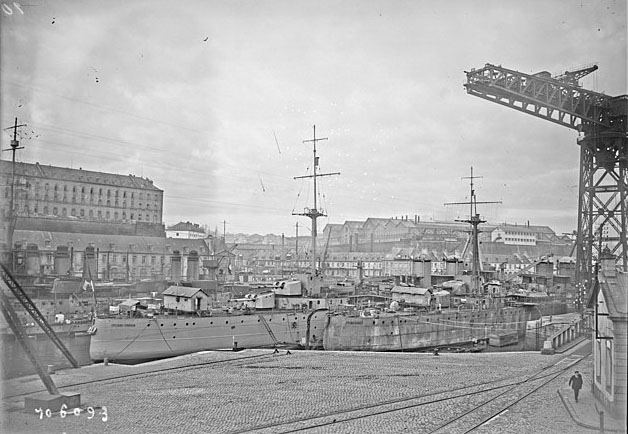
Primauguet in Brest prewar
Primauguet was commissioned in April 1927; She started her shakedown cruiser by a seven-month world tour, back in mid-December. This styme of yearly extended cruises went on until April 1932, until she was reassigned to the Far East station, followed by a home refit in January 1936. Back in French Indochina by November 1937, she was relieved by Suffren and went back home.
As the war commenced in September 1939, she was asigned to Atlantic patrols, between convoy escort missions and trying to catch Axis shipping and possible commerce raiders and blockade runners. On 1 April 1940, she was based at Fort-de-France, French Carribean (West Indies), relieving Jeanne d’Arc. She operated also in Curaçao and Dutch West Indies waters and managed to intercept and board for inspection several suspicious merchant ships.
On 6 May 1940 with her sister ship and Primauguet, under command of Captain Pierre Goybet, she relieved the sloop HMS Dundee off Aruba. As the Western campaign started and after the Dutch surrender, she landed forces to secure the extensive Dutch oil installations. Next, she was oordered to cross the Atlantic to the West African, port of Dakar on 12 June 1940, after France herself surrendered.
She was naturally placed under command of the Vichy French Navy command. She carried a remainder of French Gold Reserves in Africa. She was stationed in Dakar in July 1940, at the time of the British attack on Mers-el-Kebir, receiving orders to be placed in high readiness for possible operations. She escorted a French oiler sent in support of three La Galissonnière-class cruisers of the 4th Squadron operating from Libreville, French Equatorial Africa. There, they were to act against coastal strongholds of the Free French in Western Africa.
In the Bight of Benin, they encountered the British cruisers HMS Cornwall and Delhi. Rather than ordering general quarters as indicated by Vichy in that occurence, Captain Goybet signalled he would sent a cutter for negociations. It was agreed that the two forces would just pass each others and be re-routed for the French. In between Primauguet received the order to turn back to Casablanca by Admiral Bourague, aboard Georges Leygues.
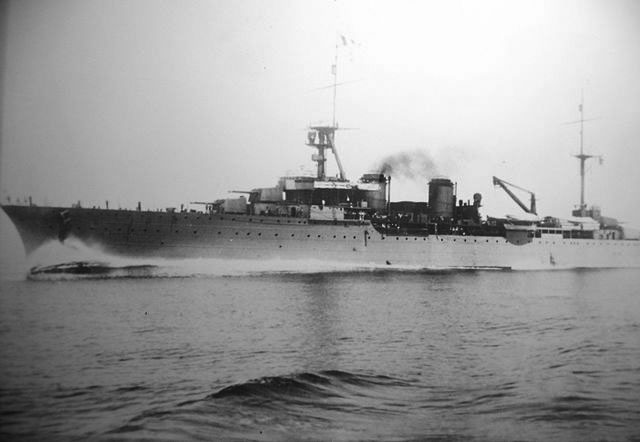
Primauguet at full speed, personal photo of Captain Goybet, in WW2 (originally in color), circa 1941.
On 8 November 1941, she was in refit in Casablanca. But die to the lack of parts from the homeland, this was not over a uyear after: She was still there when the naval Battle of Casablanca started, as part of Operation Torch. Although under orders to attack leaving the captain little choice, he knew against the allied armada her had little chances of success. She sailed away, immediately to be shelled by the US battleship Massachusetts plus the New Oerlands class heavy cruisers USS Wichita, Tuscaloosa and Augusta, as well USS Brooklyn.
Already badly damaged due to her very thin protection, she was engaged by no less than four waves of SBD Dauntless dive-bombers from USS Ranger? With her weak and bolsolete AA she could do nothing to stop them. Despite her speed and try to dodge dives, she was soon frames by several near-misses which badly shook her, followed by no less than six direct hits.
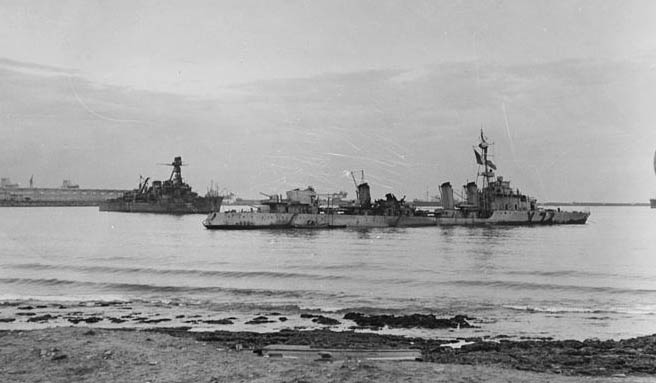
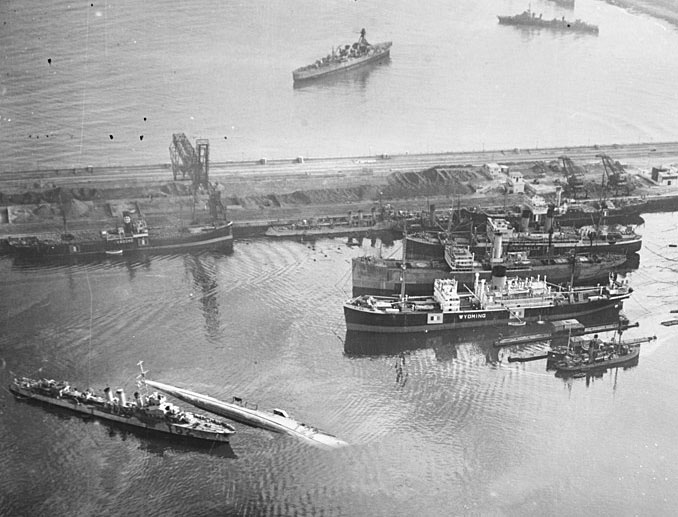
The battle of Casablanca, Primauguet and the destroyers Albatros and other vessels laying in the port after the battle, December 1942.
Soon she was almost immobilized, listing and burning all the way through. To allow the crew to be evacuated before capsizing, captan Goybet decided with that little power he still had, to aim at the coast and dropping anchor in shallow waters. After order was given to abandon ship, Primauguet was left to burnt out overnight. Other sources stated she ran aground, but photos tends to show her lying at anchor and still afloat. Her wreck was sold in 1951 and BU in situ.
 Lamotte-Picquet
Lamotte-Picquet
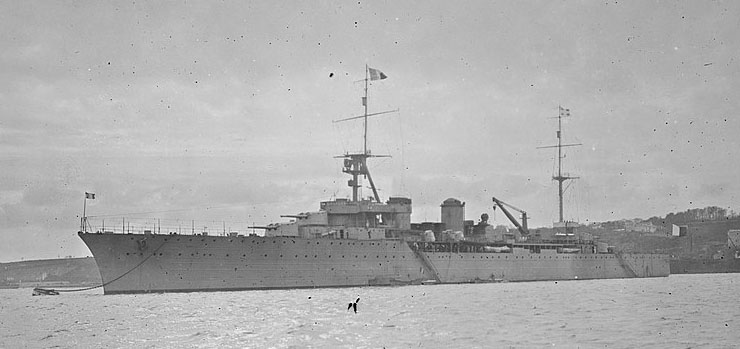
Lamotte-Picquet in Brest before the war
Completed in 1927, Lamotte-Picquet was based in Brest until 1933, with the 3rd Light Division as flagship. In 1935, she was ordered to the Far East, French Indochina, and stayed there until September 1939. Afterwards, she patrolled around French Indochina, as well as the Dutch East Indies.

Lamotte-Picquet in Shanghai, circa 1939. Left is the British light cruiser Birmingham’s tern and bow of the U.S. Navy troop transport USS Chaumont, right. Also spotted in the frame are the Danish steamer Promise British steamer Yingchow (right background), British steamer Shantung (right foreground) Src Official U.S. Navy photo NH 81987 from the U.S. Navy Naval History and Heritage Command.
After the French surrender, tensions with Siam (now Thailand) fuelled by Japan eventually led to fully flegded hostilities with Vichy France and an invasion started in December 1940. By January 1941, Lamotte-Picquet, as flagship of a small squadron called “Groupe Occasionnel” formed on 9 December at Cam Ranh Bay (Saigon) departed for action. Under Captane Bérenger she led the colonial sloops Dumont d’Urville and Amiral Charner and the WWI vintage sloops Tahure and Marne in the Koh Chang islands, to find and destroy the Thai Navy. Complete description of the battle.
The latter Thai squadron comprised two torpedo boats and the coastal defence ship HTMS Thonburi, which were shelled, sunk or badly damaged on 14 January 1941. The victory was not very ueseful anyway as on the ground the situation degenerated and utimately, with German pressure on Vichy France, the Japanese forced a compromise and settlement in favour of Thailand. The cruiser stayed in Saigon for the remainder of the war, apart a visit to Osaka, Japan in September 1941.
Use for training she was sunk ultimately evacuated in Đồng Nai River as the fight intensified on 12 January 1945. She was spotted by U.S carrier based aircraft from Task Force 38 during the South China Sea raid and bombed until she capsized and sank, fortunately evacuated. The hull was scrapped in situ after the war.
Src/ Read More
Books
Guiglini, Jean; Moreau, Albert. Les Croiseurs De 8000 Tonnes. Marines Edition
Godefroy, René-Emile (1953). L’Aventure de la force X (escadre française de la Méditerranée orientale) à Alexandrie (in French). Plon.
Guiglini, Jean & Moreau, Albert (2001). “French Light Cruisers: The First Light Cruisers of the 1922 Naval Program”. Warship International. XXXVIII
Jordan, John & Moulin, Jean (2013). French Cruisers 1922–1956. Seaforth Publishing.
Whitley, Michael J. (1995). Cruisers of World War II: An International Encyclopedia. Arms and Armour Press.
Conway’s all the world’s fighting ships 1921-1947
Links
about the 155 mm guns on navweaps
The actions of Duguay Trouin at Setif, May 1945
Captain J.Trolley de Prevaux on ordredelaliberation.fr
On secondeguerre.net (my old article by the way)
memorial-national-des-marins.fr
Lamotte Picquet at wrecksite.eu
Lamotte-Picquet Full history on netmarine.net
Model Kits
Detailed official Plans
GHQ models metal 1:2400
XP Forge | No. 1200-Duguay-Trouin | 1:1200.
So apart the boarding games, this class seems to have inspired none. No other scale can be found.







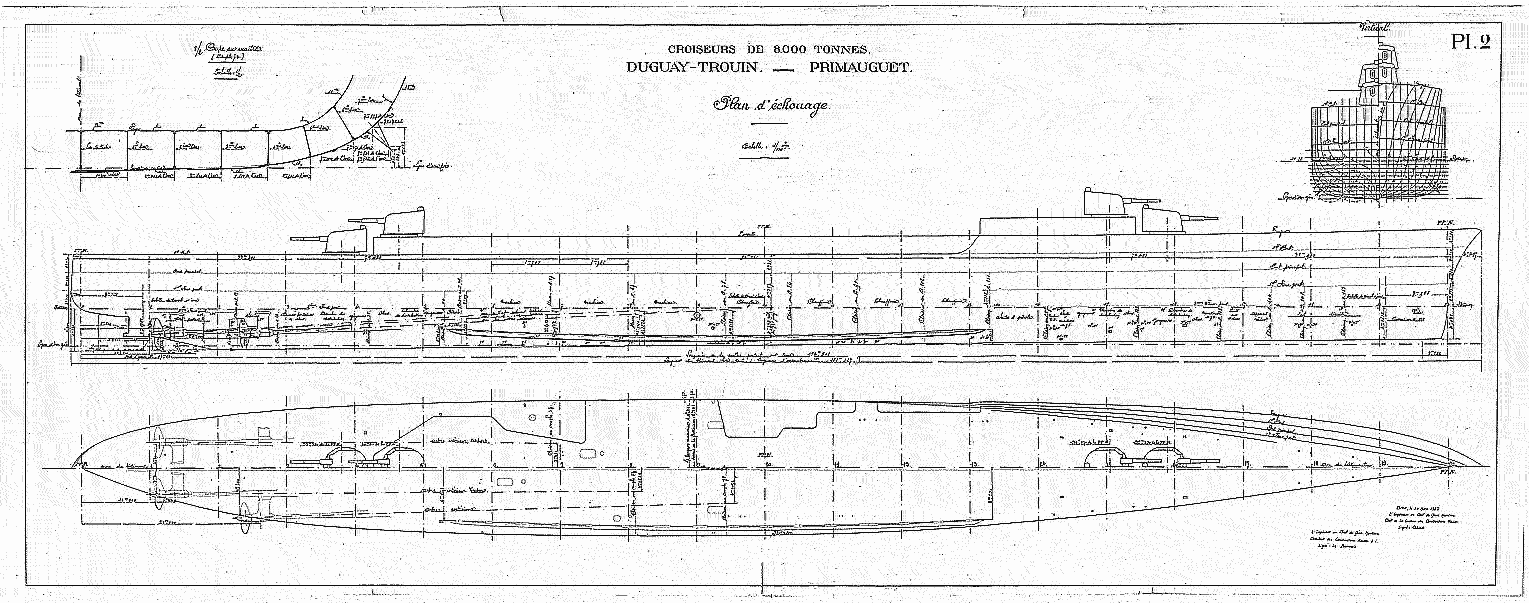


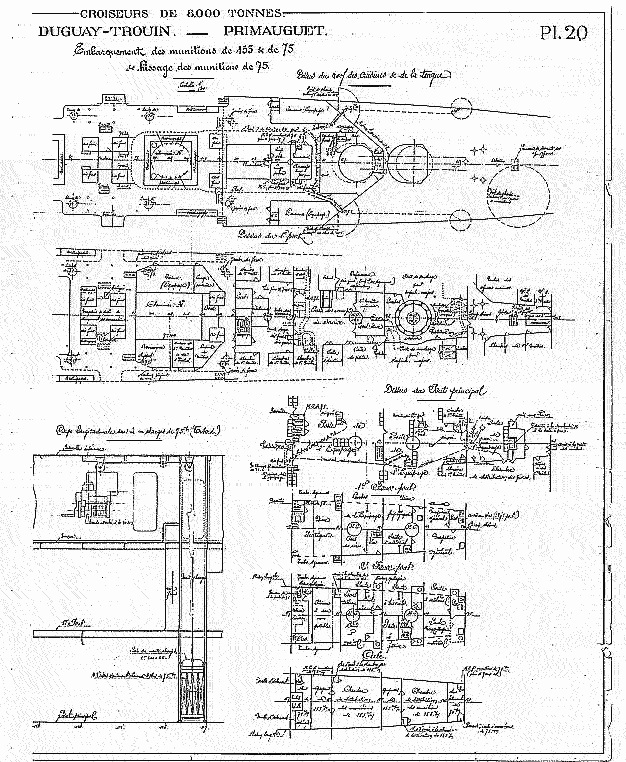
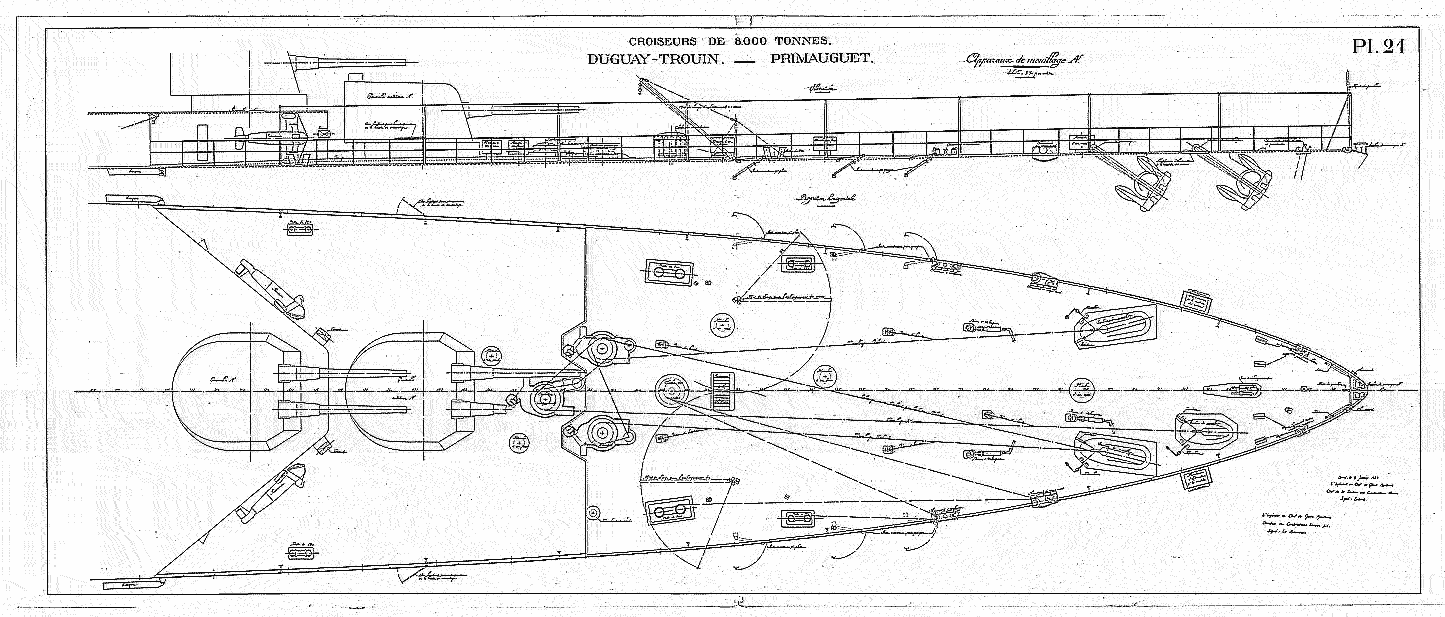
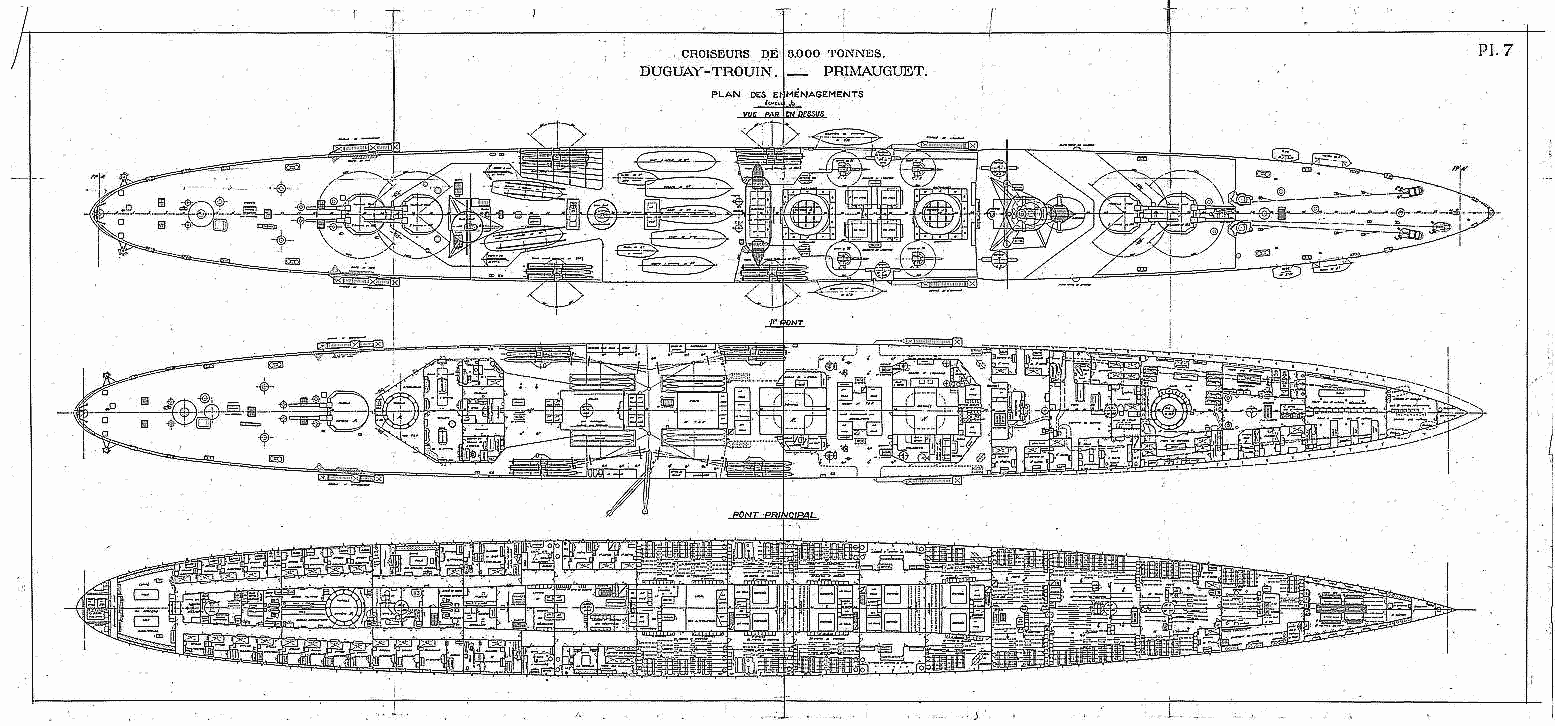

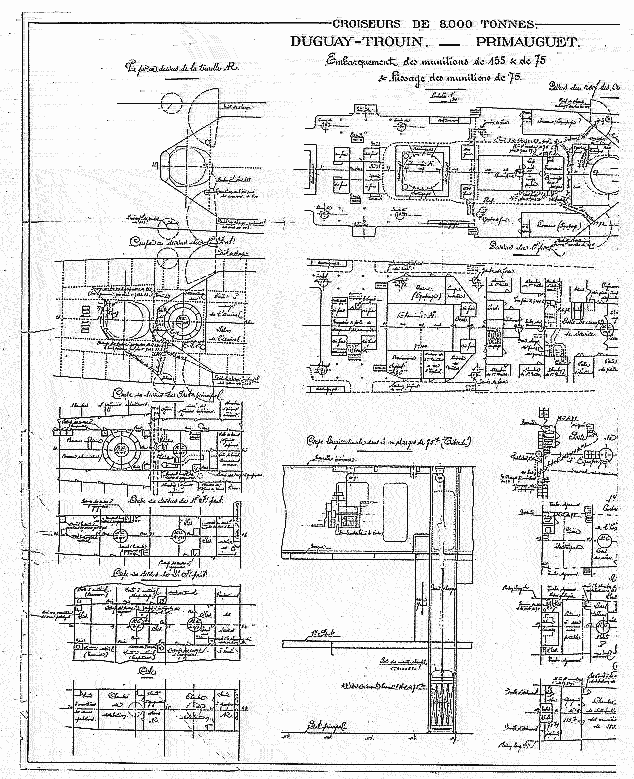

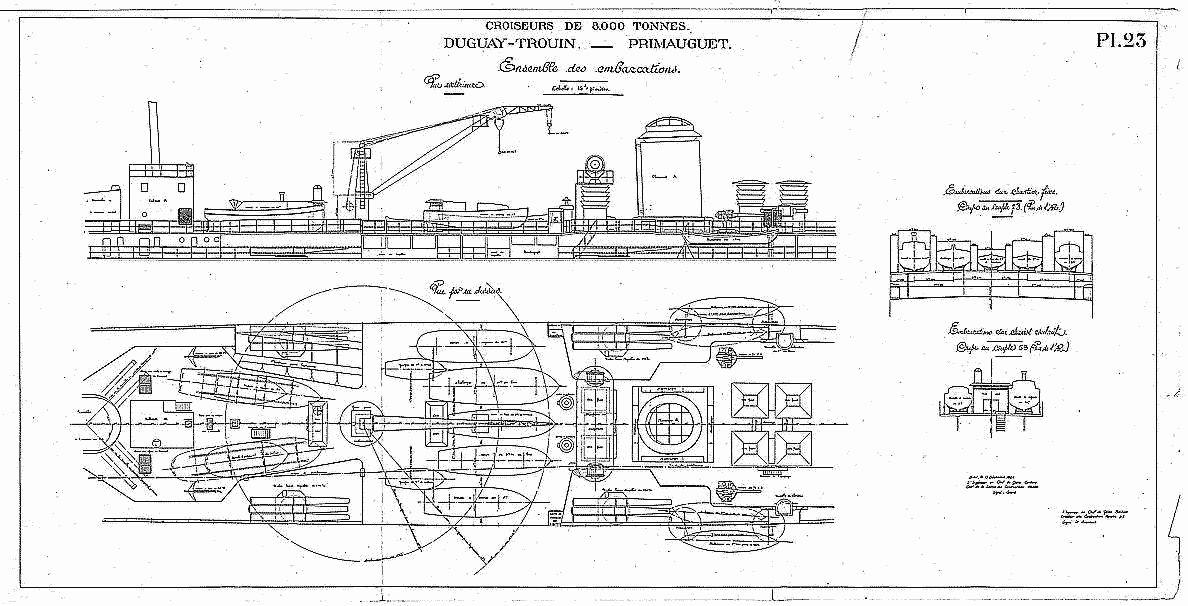
 Latest Facebook Entry -
Latest Facebook Entry -  X(Tweeter) Naval Encyclopedia's deck archive
X(Tweeter) Naval Encyclopedia's deck archive Instagram (@navalencyc)
Instagram (@navalencyc)





 French Navy
French Navy Royal Navy
Royal Navy Russian Navy
Russian Navy Armada Espanola
Armada Espanola Austrian Navy
Austrian Navy K.u.K. Kriegsmarine
K.u.K. Kriegsmarine Dansk Marine
Dansk Marine Nautiko Hellenon
Nautiko Hellenon Koninklije Marine 1870
Koninklije Marine 1870 Marinha do Brasil
Marinha do Brasil Osmanlı Donanması
Osmanlı Donanması Marina Do Peru
Marina Do Peru Marinha do Portugal
Marinha do Portugal Regia Marina 1870
Regia Marina 1870 Nihhon Kaigun 1870
Nihhon Kaigun 1870 Preußische Marine 1870
Preußische Marine 1870 Russkiy Flot 1870
Russkiy Flot 1870 Svenska marinen
Svenska marinen Søværnet
Søværnet Union Navy
Union Navy Confederate Navy
Confederate Navy Armada de Argentina
Armada de Argentina Imperial Chinese Navy
Imperial Chinese Navy Marinha do Portugal
Marinha do Portugal Mexico
Mexico Kaiserliche Marine
Kaiserliche Marine 1898 US Navy
1898 US Navy Sovietskiy Flot
Sovietskiy Flot Royal Canadian Navy
Royal Canadian Navy Royal Australian Navy
Royal Australian Navy RNZN Fleet
RNZN Fleet Chinese Navy 1937
Chinese Navy 1937 Kriegsmarine
Kriegsmarine Chilean Navy
Chilean Navy Danish Navy
Danish Navy Finnish Navy
Finnish Navy Hellenic Navy
Hellenic Navy Polish Navy
Polish Navy Romanian Navy
Romanian Navy Turkish Navy
Turkish Navy Royal Yugoslav Navy
Royal Yugoslav Navy Royal Thai Navy
Royal Thai Navy Minor Navies
Minor Navies Albania
Albania Austria
Austria Belgium
Belgium Columbia
Columbia Costa Rica
Costa Rica Cuba
Cuba Czechoslovakia
Czechoslovakia Dominican Republic
Dominican Republic Haiti
Haiti Hungary
Hungary Honduras
Honduras Estonia
Estonia Iceland
Iceland Eire
Eire Equador
Equador Iran
Iran Iraq
Iraq Latvia
Latvia Liberia
Liberia Lithuania
Lithuania Mandchukuo
Mandchukuo Morocco
Morocco Nicaragua
Nicaragua Persia
Persia San Salvador
San Salvador Sarawak
Sarawak Uruguay
Uruguay Venezuela
Venezuela Zanzibar
Zanzibar Warsaw Pact Navies
Warsaw Pact Navies Bulgaria
Bulgaria Hungary
Hungary

 Bundesmarine
Bundesmarine Dutch Navy
Dutch Navy Hellenic Navy
Hellenic Navy Marina Militare
Marina Militare Yugoslav Navy
Yugoslav Navy Chinese Navy
Chinese Navy Indian Navy
Indian Navy Indonesian Navy
Indonesian Navy JMSDF
JMSDF North Korean Navy
North Korean Navy Pakistani Navy
Pakistani Navy Philippines Navy
Philippines Navy ROKN
ROKN Rep. of Singapore Navy
Rep. of Singapore Navy Taiwanese Navy
Taiwanese Navy IDF Navy
IDF Navy Saudi Navy
Saudi Navy Royal New Zealand Navy
Royal New Zealand Navy Egyptian Navy
Egyptian Navy South African Navy
South African Navy






























 Ukrainian Navy
Ukrainian Navy dbodesign
dbodesign